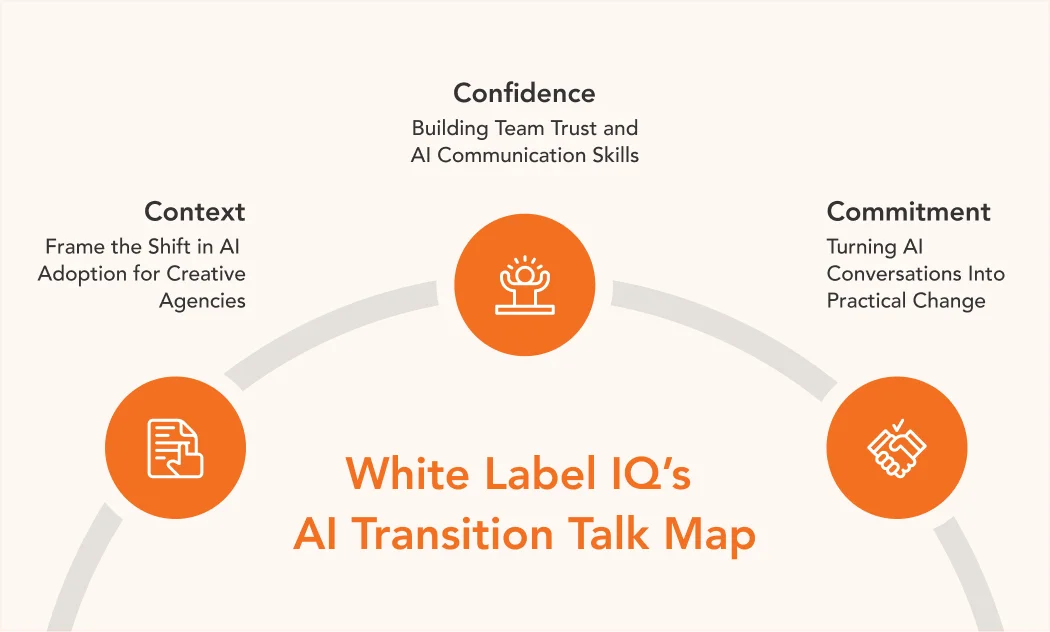
This Feels Like 1996 Again
Every 20 years, agencies hit a moment that rewrites how they work.
In the late ’90s, it was the Internet. The skeptics called it a fad. The believers built their next decade on it.
AI is that scale of shift—different technology, same tension.
The difference? It’s unfolding inside your agency right now.
Your team’s experimenting with ChatGPT or Midjourney. Someone’s nervous about job security. Someone else is quietly automating proposals.
And you—the agency leader—are caught between excitement and unease.
You know AI could unlock a new level of efficiency and creative scale.
You also know it could erode trust if adopted recklessly.
According to Microsoft and LinkedIn’s Work Trend Index 2024, 75% of knowledge workers already use AI at work—and 78% are bringing their own AI (BYOAI).
Yet only 39% have received training, and just 25% of companies plan to offer it this year. That gap isn’t technical—it’s cultural. It’s where governance turns from policy into protection.
This isn’t a conversation about tools.
It’s about how to talk about AI—how to turn uncertainty into curiosity, and curiosity into momentum.
Because the next big shift isn’t coming.
It’s already here.
Recognizing The Emotions Behind AI Communication For Teams
Inside every agency right now, AI isn’t just a capability—it’s a conversation. One that’s happening in fragments, whispers, and private browser tabs.
Half your team is curious—testing prompts between client calls, automating recaps, tweaking visuals.
The other half is cautious—wondering if those experiments will make their roles obsolete.
No one’s entirely wrong. But no one’s saying it out loud, either.
That silence? It’s not laziness. It’s self-protection.
According to KPMG’s 2025 U.S. Workforce AI Study, 44% of employees use AI in ways their employers haven’t authorized, and 46% admit uploading sensitive company information to public AI tools.
Nearly half of U.S. workers now use AI outside company policy—proof that “Shadow AI” isn’t theory, it’s Tuesday.
As a leader, you feel that contradiction daily:
You want innovation—but not chaos.
You want momentum—but not mistakes.
You want to champion the future—but not lose the trust that built your agency in the first place.
Here’s the truth: uncertainty doesn’t mean resistance.
It means attention. It means your team knows something big is happening—they just don’t know where they fit in yet.
Silence around AI isn’t comfort—it’s caution in disguise.
And that’s where leadership begins—not with answers, but with language that makes curiosity feel safe again.
Reframing Fear: How Agency AI Leadership Turns Anxiety Into Readiness
Every major shift in agency history has sounded the same at first: “This might change everything.”
The Internet did. Mobile did. Social did.
And AI—once again—is doing it in real time.
The hesitation you hear in your team’s voice? That’s not defiance.
It’s awareness.
People don’t resist what they don’t understand—they resist what they know will demand something of them.
Fear is a form of readiness.
It signals that your team already senses the scale of change ahead.
That’s not a problem to fix—it’s energy waiting for direction.
The real risk isn’t fear. It’s silence.
That’s where “Shadow AI”creeps in—when curiosity operates without communication, and ambition runs faster than guardrails.
According to the 4A’s and Forrester’s State of GenAI Adoption 2025, 75% of agencies already use Generative AI—up from 61% last year—but 77% cite legal and privacy as their top barriers.
That’s your cue to lead with structure, not slogans.
It’s a reminder that structured experimentation—not ad-hoc enthusiasm—is how agencies scale safely.
NIST’s AI Risk Management Framework backs this up: the GOVERN function “cultivates and implements a culture of risk management,” and every other function operates “as defined by the GOVERN function.”
Governance sets tone before tools set pace—and that’s leadership in action.
The next step: giving that dialogue structure.
White Label IQ’s AI Transition Talk Map For Agency Leaders
You don’t need another AI playbook—you need a way to talk about AI that keeps your team aligned and unafraid.
That’s why we built White Label IQ’s AI Transition Talk Map—a three-part framework that turns tension into traction.

Context—Frame The Shift In AI Adoption For Creative Agencies
Start with why, not what.
When the Internet arrived, the agencies that thrived weren’t the ones who mastered code first—they were the ones who explained why digital mattered.
Frame AI the same way: as a natural next phase in creative evolution, not an invasion. Say it plainly: “AI isn’t here to replace judgment—it’s here to accelerate it.”
Give your team context that connects technology to purpose—saving time for strategy, freeing budgets for ideas, protecting creative energy.
When the “why” feels human, the “how” feels safe.
Every AI conversation is a culture conversation first.
Confidence—Building Team Trust And AI Communication Skills
Next, lower the stakes. Replace pressure with permission.
Model curiosity yourself. Show—not tell—that learning is expected.
Ask: “What’s one task AI could make easier for us?”
That question turns speculation into shared problem-solving.
Microsoft & LinkedIn’s Work Trend Index 2024 found 75% of professionals already use AI, yet 39% report no training.
Confidence doesn’t come from policy—it comes from guided exploration.
Create “sandbox” sessions where teams demo safe use cases, and celebrate what’s learned, not what’s perfect.
Peer cue: “Try it, share it, teach it.”
It’s the fastest way to replace fear with fluency.
Commitment—Turning AI Conversations Into Practical Change
Ideas fade without visible proof. Anchor curiosity in small, time-bound pilots. Start with low-risk areas—internal summaries, admin work, or first-draft ideation.
Document results, share learnings, and invite feedback.
That transparency builds credibility faster than any memo.
Link back to your Shadow AI policies—clarify what’s safe, what’s private, and where AI can truly add value.
Because progress doesn’t begin with control—it begins with conversation.
When Context, Confidence, and Commitment align, AI stops feeling abstract.
It becomes something the agency owns—together.
AI Readiness Checklist: What To Do Before Talking AI To Your Team
Even the right message falls flat without the right prep.
Before you gather your team, take five quiet minutes with this checklist—your preflight for the next big conversation.
1. Align Your Narrative
Decide what story you’re telling.
AI isn’t about tools—it’s about agency evolution. Anchor your message in that truth before you talk.
2. Define Guardrails
Make AI safe before you make it scalable.
Clarify what counts as client-safe use and what belongs only in internal sandboxes.
3. Celebrate Learners
Reward curiosity, not compliance.
Highlight early adopters who document and share responsibly—your culture will follow their lead.
4. Clarify Impact
Explain what AI means for time, not titles.
It’s here to eliminate inefficiency, not identity. The goal is to amplify creative focus, not automate it away.
5. Document Next Steps
End every AI discussion with one tangible action—an experiment, a reflection, a lesson to bring back next week.
Momentum is built in micro-wins.
Evidence backs it.
In a Harvard Business School and BCG field experiment, consultants using GPT-4 completed 12% more tasks, 25% faster, and delivered over 40% higher quality—but only when tasks fit AI’s strengths.
In the wrong tasks, accuracy dropped.
Start small, choose wisely, and scale what works.
White Label Iq’s Ai Transition Talk Map
Built from our own experience guiding agency AI transitions at White Label IQ, the Talk Map helps leaders communicate with confidence—not compliance.
Empowerment—Leading AI Adoption In Agencies With Clarity And Confidence
Every agency era has a moment that separates those who adapt from those who wait. In 1996, it was the Internet. In 2008, it was mobile.
In 2025—it’s AI.
You don’t need to predict every change.
You just need to guide your team through the first ones.
AI leadership isn’t about knowing the answers—it’s about shaping the questions that keep curiosity alive and risk contained.
Your job isn’t to rush adoption. It’s to build the trust that makes adoption possible.
Because when communication breaks, experimentation hides.
But when communication flows, innovation compounds.
The Internet reshaped how agencies worked.
AI will redefine who they become.
You don’t need another playbook.
You need a starting point—and a reason to move.
The next Internet moment isn’t coming.
It’s happening inside your agency right now.
Start leading it.
Once your team’s ready to talk AI openly, the next challenge is defining who actually owns it. That’s where our writeup “Who Owns AI in Your Agency?”, gives a framework for assigning clear leadership and accountability.
FAQs
What’s The Biggest Mistake Agencies Make With AI Adoption?
Treating AI as a tech rollout instead of a culture shift.
Without clear communication and guardrails, curiosity goes underground—creating “Shadow AI” that risks client data and trust.
Leading with dialogue, not directives, keeps adoption transparent and safe.
How Should Agency Leaders Talk About AI With Their Teams?
Start with context, not control.
Frame AI as an evolution of agency craft, not a threat to it.
Use White Label IQ’s AI Transition Talk Map to connect context, confidence, and commitment in every conversation.
Why Compare AI To The Internet Shift?
Because both redefined how agencies work, deliver, and grow. In the ’90s, those who framed the Internet as opportunity—not disruption—built the next decade of advantage.
AI is that same scale of inflection—different tools, same pattern of change.
What Is White Label IQ’s AI Transition Talk Map?
It’s a leadership framework that helps agencies guide internal AI conversations safely and strategically.
It turns fear into focus by connecting three stages—Context, Confidence, and Commitment—so adoption feels guided, not forced.
How Can Agencies Begin AI Adoption Without Risking Client Trust?
Start internally.
Run small, documented pilots using non-client data.
Communicate openly about what’s being tested, what’s off-limits, and what’s learned. That’s the same transparency White Label IQ applies to every partnership—guardrails first, innovation second.